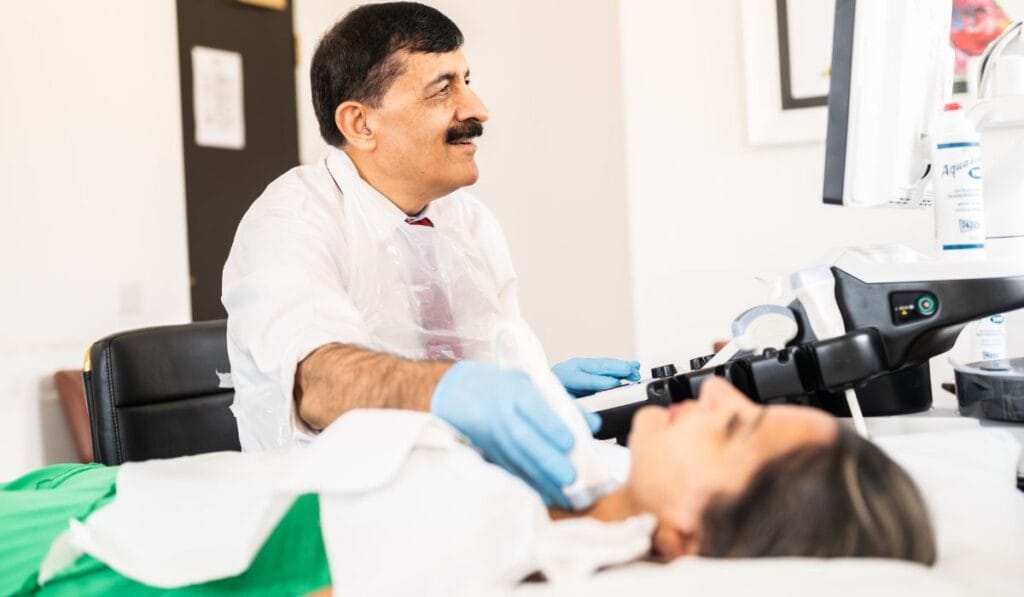Treatments, options and pricing
Browse and click below to book any of our available Ultrasound Scanning.
Abdomen Ultrasound Scan: Upper
Included in the Abdomen Ultrasound Scan: Upper
The upper abdomen ultrasound is ideal for assessing conditions related to the pancreas, liver, kidneys, gall bladder, spleen, and aorta.
Symptoms like abdominal pain, jaundice, unexplained weight loss, and digestive issues may indicate problems in these areas.
It’s particularly useful for evaluating liver diseases, kidney stones, and issues related to the pancreas and gall bladder.
This scan can reveal the size, shape, and any abnormalities in the upper abdominal organs.
It’s effective in detecting cysts, tumours, blockages in the bile ducts, kidney stones, and changes in the aorta.
This ultrasound provides crucial insights into the health and function of these vital organs.
Abdomen Ultrasound Scan: Lower
Included in the Abdomen Ultrasound Scan: Lower
A lower abdomen ultrasound scan is a safe, non-invasive test that uses sound waves to create detailed images of internal organs, including the bladder, uterus, ovaries, and prostate.
It helps detect conditions such as cysts, inflammation, or structural abnormalities, supporting accurate diagnosis and treatment planning.
Abdomen Ultrasound Scan: Upper and Lower
Included in the Abdomen Ultrasound Scan: Upper and Lower
This comprehensive scan covers both the upper and lower abdomen, suitable for a range of symptoms affecting the abdomen.
It’s recommended for patients experiencing comprehensive abdominal issues, providing a thorough evaluation of the abdominal region.
It combines the insights of both upper and lower abdomen scans, offering a detailed view of the abdominal organs.
This can help in diagnosing a wide range of conditions affecting these areas.
Abdomen and Scrotum Ultrasound Scan
Included in the Abdomen and Scrotum Ultrasound Scan
This scan is beneficial for evaluating abdominal issues along with scrotal or testicular problems.
It’s recommended for abdominal pain combined with discomfort or swelling in the scrotal area.
The scan provides detailed images of both the abdominal organs and the scrotum, aiding in the diagnosis of conditions affecting these areas.
Abdominal Diastasis Recti Check
Included in the Abdominal Diastasis Recti Check
This scan is specifically for checking the separation of the abdominal muscles, often a concern after pregnancy.
It’s crucial for those experiencing a bulge in the stomach area or for postpartum women concerned about muscle separation.
The scan will show the extent of muscle separation and help in planning appropriate treatment or exercises for recovery.
Axilla/Armpit Ultrasound Scan: One Side
Included in the Axilla/Armpit Ultrasound Scan: One Side
An axilla (armpit) ultrasound scan is a non-invasive imaging procedure used to evaluate the lymph nodes and soft tissues in the underarm area.
It is commonly performed to assess swelling, pain, or lumps, and is especially important in detecting abnormalities such as enlarged lymph nodes, cysts, or signs of infection.
In oncology, axillary ultrasound is frequently used to check for potential spread of breast cancer.
The scan is safe, painless, and involves using high-frequency sound waves to create real-time images, providing valuable information for diagnosis and treatment planning.
Axilla/Armpit Ultrasound Scan: Both Side
Included in the Axilla/Armpit Ultrasound Scan: Both Side
An axilla (armpit) ultrasound scan is a non-invasive imaging procedure used to evaluate the lymph nodes and soft tissues in the underarm area.
It is commonly performed to assess swelling, pain, or lumps, and is especially important in detecting abnormalities such as enlarged lymph nodes, cysts, or signs of infection.
In oncology, axillary ultrasound is frequently used to check for potential spread of breast cancer.
The scan is safe, painless, and involves using high-frequency sound waves to create real-time images, providing valuable information for diagnosis and treatment planning.
Elbow Ultrasound Scan Single
Included in the Elbow Ultrasound Scan Single
Suitable for elbow pain, swelling, or mobility issues and conditions such as tennis elbow and golfer’s elbow.
It’s beneficial for sports injuries, repetitive strain injuries, or arthritis in the elbow.
The scan provides insights into the elbow’s tendons, joints, and ligaments, identifying conditions like tendonitis or bursitis.
It can also be used to assess suitability for injection therapy.
Elbow Ultrasound Scan Both
Included in the Elbow Ultrasound Scan Both
Suitable for elbow pain, swelling, or mobility issues and conditions such as tennis elbow and golfer’s elbow.
It’s beneficial for sports injuries, repetitive strain injuries, or arthritis in the elbow.
The scan provides insights into the elbow’s tendons, joints, and ligaments, identifying conditions like tendonitis or bursitis.
It can also be used to assess suitability for injection therapy.
Foot Ultrasound Scan Single
Included in the Foot Ultrasound Scan Single
Ideal for foot pain, swelling, or injuries.
It’s particularly useful for athletes or individuals with foot deformities or chronic conditions like plantar fasciitis.
It reveals the internal structures of the foot, aiding in the diagnosis of tendon injuries, cysts, or joint issues.
Foot Ultrasound Scan Both
Included in the Foot Ultrasound Scan Both
Ideal for foot pain, swelling, or injuries.
It’s particularly useful for athletes or individuals with foot deformities or chronic conditions like plantar fasciitis.
It reveals the internal structures of the foot, aiding in the diagnosis of tendon injuries, cysts, or joint issues.
Groin Ultrasound Scan One Side
Included in the Groin Ultrasound Scan One Side
This scan is vital for diagnosing groin pain or swelling.
It’s recommended for athletes or individuals with injuries or unexplained groin discomfort.
It offers detailed images of the groin area, aiding in the diagnosis of hernias, muscle strains, or lymph node enlargement.
Groin Ultrasound Scan Both Sides
Included in the Groin Ultrasound Scan Both Sides
This scan is vital for diagnosing groin pain or swelling.
It’s recommended for athletes or individuals with injuries or unexplained groin discomfort.
It offers detailed images of the groin area, aiding in the diagnosis of hernias, muscle strains, or lymph node enlargement.
Hand Ultrasound Scan Single
Included in the Hand Ultrasound Scan Single
Ideal for diagnosing hand issues like tendon injuries, joint problems, or unexplained pain.
seful for athletes or those with trauma or repetitive strain.
Provides clear images to detect tendonitis, tears, cysts, or synovitis.
Hand Ultrasound Scan Both
Included in the Hand Ultrasound Scan Both
Ideal for diagnosing hand issues like tendon injuries, joint problems, or unexplained pain.
Useful for athletes or those with trauma or repetitive strain.
Provides clear images to detect tendonitis, tears, cysts, or synovitis.
Hip Ultrasound Scan Single
Included in the Hip Ultrasound Scan Single
Suitable for hip pain, stiffness, or joint issues.
It’s particularly valuable for athletes or older individuals experiencing hip discomfort or mobility issues.
It provides a clear view of the hip joint and surrounding tissues, helping in diagnosing conditions like hip dysplasia, bursitis, or tendonitis.
Hip Ultrasound Scan Both
Included in the Hip Ultrasound Scan Both
Suitable for hip pain, stiffness, or joint issues.
It’s particularly valuable for athletes or older individuals experiencing hip discomfort or mobility issues.
It provides a clear view of the hip joint and surrounding tissues, helping in diagnosing conditions like hip dysplasia, bursitis, or tendonitis.
Kidneys and Urinary Bladder Ultrasound Scan
Included in the Kidneys and Urinary Bladder Ultrasound Scan
This ultrasound is specialised for assessing kidney and bladder health. It’s recommended for symptoms like painful urination, frequent urination, and lower back pain.
It’s key for evaluating urinary tract infections, bladder issues, and kidney health, but is not used for gallstones, liver, or pancreas issues.
The scan can show kidney sizes and any abnormalities, such as cysts or tumours.
It also evaluates bladder health, identifying conditions like bladder stones, unusual growths or structural abnormalities.
Knee Ultrasound Scan Single
Included in the Knee Ultrasound Scan Single
Suitable for knee pain, stiffness, or joint problems.
It’s especially beneficial for athletes or older adults experiencing knee discomfort or mobility issues.
It offers a detailed image of the knee joint and surrounding tissues, aiding in the diagnosis of conditions such as knee osteoarthritis, meniscus tears, or ligament injuries.
Knee Ultrasound Scan Both
Included in the Knee Ultrasound Scan Both
Suitable for knee pain, stiffness, or joint problems.
It’s especially beneficial for athletes or older adults experiencing knee discomfort or mobility issues.
It offers a detailed image of the knee joint and surrounding tissues, aiding in the diagnosis of conditions such as knee osteoarthritis, meniscus tears, or ligament injuries.
Neck and Thyroid Ultrasound Scan
Included in the Neck and Thyroid Ultrasound Scan
A neck and thyroid ultrasound scan is a safe, non-invasive test that uses sound waves to assess the thyroid gland, lymph nodes, and nearby tissues.
It helps detect thyroid nodules, cysts, swelling, or other abnormalities, supporting accurate diagnosis and ongoing monitoring of thyroid health.
**This scan does not assess the spine
Pelvic Ultrasound Scan: External Only
Included in the Pelvic Ultrasound Scan: External Only
An external pelvic ultrasound scan is a safe, non-invasive test that uses a gel and a transducer placed on the abdomen to create clear images of the pelvic organs.
It helps assess the uterus, ovaries, and bladder, allowing doctors to detect abnormalities, monitor conditions, and support accurate diagnosis.
Pelvic Ultrasound Scan: External & Internal
Included in the Pelvic Ultrasound Scan: External & Internal
A pelvic ultrasound scan, using both abdominal and transvaginal imaging, provides a detailed assessment of the pelvic organs.
This combined approach allows a clearer view of the uterus, ovaries, fallopian tubes, and surrounding tissues, helping to identify abnormalities and support accurate diagnosis.
Scrotum / Testes Ultrasound Scan
Included in the Scrotum / Testes Ultrasound Scan
This scan is crucial for scrotal pain, swelling, or lumps.
It’s recommended for detecting testicular issues, such as tumours, cysts, or varicoceles.
It provides detailed images of the scrotum and testes, aiding in the diagnosis of testicular disorders or abnormalities.
Shoulder Ultrasound Scan Single
Included in the Shoulder Ultrasound Scan Single
This scan is recommended for shoulder pain, stiffness, or injury.
It’s essential for diagnosing rotator cuff injuries, tendonitis, or bursitis in the shoulder.
The scan shows detailed images of the shoulder’s tendons, ligaments, and joints, providing crucial information for diagnosing shoulder-related conditions, including assessing the severity of any muscle tears.
Soft Tissue Lumps Ultrasound Scan
Included in the Soft Tissue Lumps Ultrasound Scan
A soft tissue lumps ultrasound is a safe, non-invasive imaging test used to examine lumps or masses found under the skin.
It helps determine the nature of the lump—whether it’s solid, fluid-filled (like a cyst), or a mix of both.
This scan is commonly used to assess lumps in areas such as the arms, legs, neck, or back, and can help identify conditions like lipomas, abscesses, or sebaceous cysts.
Using high-frequency sound waves, the ultrasound provides real-time images, allowing healthcare professionals to make accurate diagnoses and guide further treatment if necessary.
Shoulder Ultrasound Scan Both
Included in the Shoulder Ultrasound Scan Both
This scan is recommended for shoulder pain, stiffness, or injury.
It’s essential for diagnosing rotator cuff injuries, tendonitis, or bursitis in the shoulder.
The scan shows detailed images of the shoulder’s tendons, ligaments, and joints, providing crucial information for diagnosing shoulder-related conditions, including assessing the severity of any muscle tears.
Wrist Ultrasound Scan Single
Included in the Wrist Ultrasound Scan Single
Ideal for diagnosing wrist issues such as tendon injuries, joint problems, or unexplained pain.
Useful for athletes or those with trauma or repetitive strain.
Provides clear images to detect tendonitis, tears, cysts, or synovitis.
Wrist Ultrasound Scan Both
Included in the Wrist Ultrasound Scan Both
Ideal for diagnosing wrist issues such as tendon injuries, joint problems, or unexplained pain.
Useful for athletes or those with trauma or repetitive strain. Provides clear images to detect tendonitis, tears, cysts, or synovitis.
Common Q&A about Ultrasound Scanning
Our FAQ section is designed to address common questions you may have, from how our treatments work to what you can expect during and after your session.
Our team is always available to provide additional support if you need more personalised guidance, ensuring that you feel informed and confident every step of the way.
Ultrasound scanning is a non-invasive imaging technique that uses high-frequency sound waves to create images of organs and structures inside the body.
Yes, ultrasound is considered safe as it does not use radiation, making it suitable for various patients, including pregnant women.
Ultrasound is used for various purposes, including examining the abdomen, pelvis, and heart, monitoring fetal development, and guiding biopsies.
Preparation may include avoiding smoking and heavy meals for a few hours before the test. Your doctor might also advise you to refrain from using inhalers or certain medications before the test. Wear loose clothing to ensure your breathing isn’t restricted.
You will lie down on an exam table, a gel will be applied to your skin, and a transducer will be moved over the area being examined to capture images.
An ultrasound typically takes between 15 to 30 minutes, but this can vary depending on the type of examination.
Ultrasound is generally painless, although you may experience slight discomfort from pressure applied by the transducer, especially if you have a full bladder.
The transducer emits sound waves that bounce off tissues and organs, and the returning echoes are processed to create images displayed on a monitor.
There are no known side effects from ultrasound scans, as they are safe and non-invasive.
Results are typically available shortly after the scan, though the time frame for receiving a detailed report may vary based on the facility.







